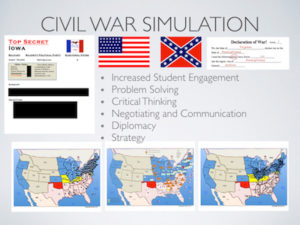On November 6th, 1860, Abraham Lincoln was elected the 16th president of the United States. Although no shots were fired, this was a strong, yet silent start to the American Civil War. In the simulation, as students vote for the candidate that matches their state’s political beliefs, they will begin the see the divide the elected creates. As the states began splitting into distinct sides, our country began battles, just as your students will be able to.
Many battles will take place as the simulation goes on, but a major battle of the American Civil War is the Battle of Fredericksburg. This battle became significant to the Civil War, as it had the largest concentration of soldiers out of any other battle with 200,000 men fighting. The Battle of Fredericksburg took place from the early hours of the morning on December 11th to the cold night of December 15th, 1862. Before the battle began, Ambrose Burnside replaced Major General McClellan, with reluctance, as the commander of the Army of the Potomac. The army was equipped with 120,000 men under the direction of Burnside. On the other side of the battlefield was Robert E. Lee and his Army of North Virginia.
As Robert E. Lee had his army stationed in Fredericksburg, the Union army experienced many delays. By November 19th, 1862, Burnside was in Falmouth, but the pontoons they wanted were late and heavy snowfall prevented any military action for a week. While the Union was delayed, Robert E. Lee and his soldiers had ample time to find advantageous defensive positions, establish supply lines, and even bring a 30-pound artillery piece to the field. Students in the simulation will be able to experience advantages like this with the Northern Industry and Railroad.
On December 11th, in the early hours of the morning, Ambrose ordered his troops to assemble their pontoon bridges and cross the Rappahannock River. Burnside believed the speed and surprise would bring success for the Union. Although his plan was hopeful, it backfired as Brigadier General William Barksdale’s Mississippians shot at the Union soldiers that were trying to assemble their pontoons. Burnside retaliated against the Mississippians, and by mid-afternoon, several Union soldiers had finally managed to drive Barksdale’s troops out of town. The Union soldiers were finally able to build their pontoons.
Finally, on December 12th, Union soldiers crossed the Rappahannock River. Lee’s soldiers were defending themselves in a seven-mile long curving line with Longstreet’s corps on the left along Marye’s Heights, and Stonewall Jackson’s corps near Prospect Hill. Once Burnside’s soldiers cross the Rappahannock, they began a two-pronged attack and hit Longstreet and Jackson’s flanks. Along with Burnside, Major General Franklin attacked Longstreet’s men while Major General Sumner hit Jackson’s. In a critical misstep, Burnside gave ambiguous orders to Franklin and Sumner on the morning of the 13th, instead of after their meeting on the 12th. Major General Franklin was unaware of how forceful her was supposed to attack the south of the sent, and only sent the 1st corps to work past the southern Confederate line. The Confederates delayed the Union advance as they had miscalculated.
The Union did not succeed anymore, and this became a major turning point for the Confederates, as they were outnumbered. The Union soldiers were able to slowly advance on Jackson’s position, but weren’t coordinated enough to finish the attack, and ended up retreating. Divisions of Union soldiers attempted to make it to Marye’s Heights, but were devastated with artillery fire time and time again. After Union soldiers retreated into the night, the Confederates stood victorious. Their morale soared after the battle while the Union soldiers, for they were outnumbered but still prevailed. The Union soldiers, who were already less than confident after Burnside was replaced with McClellan, left feeling low and unsuccessful.

